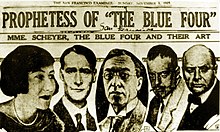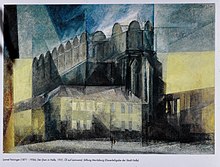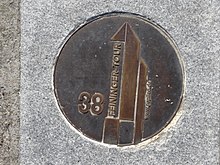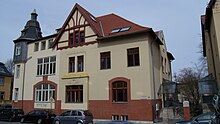Lyonel Feininger


Lyonel Charles Adrian Feininger (born July 17, 1871 in New York ; † January 13, 1956 there ) was a German-American painter , graphic artist and caricaturist . From 1909 he was a member of the Berlin Secession . With his work at the Bauhaus since 1919, he is one of the most important artists of classical modernism .
Feininger only came to painting at the age of 36. Before that, he worked as a commercial cartoonist for various German, French and American newspapers and magazines for a long time. He subjected his work to a tough, self-critical examination and, based on his caricatures, quickly developed a very distinctive painting style. In his pictures the objects are abstracted and artistically exaggerated. The strength achieved and the expression of Feininger's style influenced numerous contemporary artists and established its importance and success. Feininger often took up motifs and compositions of his own caricatures and sketches in his work .
His drawings of the small town idyll, made in Ribnitz and Damgarten in 1905, for example, became famous , as did his pictures of churches and village centers in the Weimar region in Thuringia , where he repeatedly went for work and study stays between 1906 and 1937. The pictures are usually named and numbered after the respective localities ( Gelmeroda , Niedergrunstedt , Possendorf , Mellingen , Vollersroda , Tiefurt , Taubach , Gaberndorf , Oberweimar , Zottelstedt etc.).
life and work
Leonell (Lyonel) Feininger was born as the son of two distinguished German musicians, the concert violinist Karl (later Charles) Feininger and the pianist and singer Elisabeth Feininger. In 1887, at the age of 16, Feininger came to Germany for the first time with his parents, who were on a concert tour. With their permission, he was allowed to stay there and attend the Hamburg School of Applied Arts . On October 1 of the following year, he passed the entrance exam for the Royal Academy in Berlin . He started drawing for publishers and magazines at an early age. In 1892 he began studying at the Académie Colarossi in Paris , founded by the Italian sculptor Filippo Colarossi. After seven months in Paris, he returned to Berlin in 1893, where he worked as a freelance illustrator and caricaturist for the magazines Harpers Young People , Humoristische Blätter , Ulk and the Lustige Blätter .
In 1901 Feininger married the pianist Clara Fürst, a student of Artur Schnabel and sister of the painter Edmund Fürst . After he met the artist Julia Berg , née Lilienfeld (1881–1970), in 1905 , he separated from his wife Clara and his two daughters Leonore and Marianne. In February 1906 he visited Julia in Weimar , where she studied at the Grand Ducal Art School. Together they traveled to Paris in July, where their son Andreas (1906–1999) was born. In July 1906 Feininger met Robert Delaunay and Henri Matisse in Paris . He signed a contract with the Chicago Sunday Tribune for two comic series, The Kin-der-Kids and Wee Willie Winkie's World , which are now counted among the classics of the genre, but both were discontinued early. In 1908 Lyonel and Julia married and settled in Berlin. They had two other sons, Laurence (1909–1976) and Theodore Lux (1910–2011). In 1909 he became a member of the Berlin Secession .
In 1911 six paintings by Feininger were exhibited at the Paris Salon des Artistes Indépendants ("Salon of Independent Artists") on the Pont d'Alma. The first contact with Cubism took place . In 1912 the painter got to know the artist group Brücke and produced his first architectural compositions.
Together with the artists of the Blue Rider , he took part in the First German Autumn Salon in the Berlin gallery “Der Sturm” in 1913 at the invitation of Franz Marc . In 1914 Feininger made an etching and prepared artistic models of railways for industrial toy manufacturing. He also had an exhibition with, among others. Moritz Coschell in the Arnold Gallery in Dresden. After the outbreak of the First World War , he returned to Berlin. Feininger's first solo exhibition opened on September 2, 1917 in the “Der Sturm” gallery. 45 paintings and 66 other works were shown. Another solo exhibition was shown by the Galerie Neue Kunst Hans Goltz in Munich in October 1918 . In November of the same year Feininger joined the November group initiated by Max Pechstein and César Klein and met Walter Gropius . In 1919 he was appointed by Gropius as head of the graphic workshop at the State Bauhaus in Weimar. Feininger and his family moved to Gutenbergstrasse 16 in Weimar in mid-August. Following the holistic approach of the Bauhaus, Feininger also devoted himself to music in 1921 and composed his first fugue .
Feininger liked to spend the summer months by the sea, initially alone on Rügen (from 1892), later with his wife Julia and their sons Andreas, Laurence and Theodore Lux on the island of Usedom , which he moved from quarters in Heringsdorf , Neppermin and Benz explored from by bike and where he, among other things. repeatedly painted the Benzer St. Petri Church , and from 1924 to 1935 in Deep on the Pomeranian Baltic Sea coast near Kolberg. During his stays at the sea he made many sketches ("nature notes"), the motifs of which he repeatedly used in later work.
Feininger cycle paths both around Weimar and on Usedom follow in the artist's footsteps.
As part of the series “German Painting of the 20th Century”, Deutsche Post issued a special stamp in 2002 with the painting “Market Church of Halle” by Feininger.
Feininger at the Bauhaus, involuntary end of his work in Germany

Feininger was appointed to Weimar by Walter Gropius as the first Bauhaus master to found the State Bauhaus in 1919 . Initially, he was the head of the printing workshops until 1925. Feininger lived with his family from summer 1919 to summer 1926 at Gutenbergstrasse 16 in Weimar, a house that has been preserved to this day. In 1921, a portfolio with linocuts by Feininger was published as his first Bauhaus publication. Feininger stayed in Erfurt in 1923 . In New York, 47 paintings, watercolors, drawings and prints were exhibited in the Anderson Gallery: A Collection of Modern German Art . In 1924 Feininger, Paul Klee , Wassily Kandinsky and Alexej von Jawlensky founded the exhibition group Die Blaue Vier . After the Bauhaus in Weimar had its funds cut by 50 percent in 1924 as a result of submissions from the Thuringian craftsmen and the German-ethnic bloc in the Thuringian state parliament, it was able to be re-established in Dessau in spring 1925 . On July 30, 1926, Feininger and his family moved into one of the newly built masters' houses in Dessau. At the Bauhaus, Feininger had himself released from all teaching duties at his own request. At the urging of Walter Gropius, he remained “master” until 1932.
From 1929 to 1931, at the invitation of the city of Halle (Saale), he worked on a total of eleven expressionist views of the city, in particular the market church , the so-called cathedral and the red tower . For this he had a studio in the gate tower of the Moritzburg . In 1931 the city bought all 11 paintings and 29 drawings in this cycle for its art museum .
After the victory of the NSDAP in the local elections in Dessau in 1932, the Bauhaus left the city and set up a privately run school in Berlin. Lyonel and Julia Feininger moved to Berlin-Siemensstadt in the same year . With the help of the Quedlinburg art collector Hermann Klumpp , the couple was able to leave National Socialist Germany on June 11, 1937 for the USA, where Feininger worked as a freelance painter in New York.
During the time of National Socialism , Feininger's works were officially considered “ degenerate art ”. The National Socialists confiscated 378 works by the artist from public collections. A few months after his departure, they showed eight paintings (city views), a watercolor and thirteen woodcuts at the Degenerate Art exhibition in Munich.
Feininger in New York
Feininger visited New York as early as 1936, taught in the summer months at Mills College in Oakland and prepared for his move to the United States . If Feininger was considered an American painter in Germany, he was virtually unknown to the New York public after his return as a “German”. "In the beginning I suffered a lot from the feeling of being a stranger [...]". In the summer of 1937 he taught again at Mills College and made his first watercolors ( Manhattan at Night ), in which he dealt with New York. In 1939 he completed motifs of the Baltic Sea and of Deep in Pomerania that had already been started in Germany . A year later he started a series with "Manhattan images", which had the modern "skyscraper" architecture and street canyons as the theme. But for Feininger - although he lives in New York - the remembered motifs of his former homeland always remained an important pictorial theme. In 1944 he met Fernand Léger and exhibited for the first time - together with Marsden Hartley - a retrospective at the Museum of Modern Art . In 1947 he was elected President of the Federation of American Painters and Sculptors and a year before his death a member of the National Institute of Arts and Letters .
As a member of the German Association of Artists , Feininger took part in the third annual exhibition in the Hamburger Kunsthalle in 1953 and in the years that followed, up to 1956, also exhibited in Frankfurt, Baden-Baden and Düsseldorf.
Feininger died at the age of 84 in his New York apartment (235 East 22nd Street). He was buried in Mount Hope Cemetery in Hastings-on-Hudson ( Westchester County , New York). His son Andreas Feininger became a well-known photographer in New York. His son Laurence Feininger (musicologist) died in 1976 in Freienfeld , Italy.
Works in museums
The world's only museum dedicated to the painter is located in the Harz Mountains in the World Heritage City of Quedlinburg. Hermann Klumpp lived here, who studied at the Bauhaus in Dessau from 1929 and became a friend of the Feiningers. Before Lyonel Feininger left Germany in June 1937, he left more than 60 paintings and more than 1000 works on paper in trust to his friend in order to protect them from confiscation and destruction by the National Socialists. After the deaths of Lyonel and Julia Feininger in the 1970s, lengthy, complicated negotiations took place between the children's lawyers and the GDR authorities, as a result of which almost all of the paintings were returned to the sons. 10 remaining paintings as well as the works on paper remained in the possession of Hermann Klumpp, who made them available for the foundation of the Lyonel-Feininger-Galerie in his city of Quedlinburg. In 1986 the staff museum dedicated to the painter was opened with the Dr. Hermann Klumpp opened on permanent loan. Today it holds the world's second largest collection of works by the artist. In 2019, with the establishment of the Lyonel Feininger Collection Armin Rühl Foundation, an important group of Lyonel Feininger's early caricatures and comic drawings were permanently tied to the museum.
The Harvard Art Museums in Cambridge ( USA ) keep most of Lyonel Feininger's estate and thus the most extensive collection of his work.
Further Feininger bundles can be found with the Harald Löbermann collection in the Chemnitz art collections (298 prints, drawings and watercolors from the period 1910 to 1955) and in the Moritzburg Art Museum Halle (Saale) , where three of the former 11 Halle pictures are now in the permanent collection presentation can be seen. There are also numerous watercolors, drawings, sketches, prints and photographs by the artist. In the city of Halle (Saale) , an audio walk following the footsteps of Feininger's paintings through the historic old town was established in 2019.
Works (selection)

- 1905 August: Ribnitz , Straße Am Klosterteich and view of the harbor
- 1906/1907: The white man , Collection Museo Carmen Thyssen-Bornemisza , Madrid
- 1907: Landscape study on the Baltic Sea motif , Kulturstiftung Sachsen-Anhalt , Lyonel-Feininger-Galerie , Quedlinburg, permanent loan from the Dr. Hermann Klumpp
- 1910: Street in the twilight , Sprengel Museum , Hanover
- 1910: Self-portrait with clay pipe , Kulturstiftung Sachsen-Anhalt, Lyonel-Feininger-Galerie, Quedlinburg, permanent loan from the Dr. Hermann Klumpp
- 1912: The Gate , gallery in the monastery , Ribnitz-Damgarten
- 1913: Gelmeroda I , private collection, New York
- 1913: Vollersroda I , Kulturstiftung Sachsen-Anhalt, Lyonel-Feininger-Galerie, Quedlinburg
- 1913: Leuchtbake , Folkwang Museum , Essen
- 1913: circular shapes, sun, tower , private collection, Paris
- 1918: Teltow II , New National Gallery , Berlin
- 1919: The Cathedral of Socialism , woodcut for the first Bauhaus manifesto
- 1920: Viaduct , Museum of Modern Art , New York
- 1921: Small port town , Heiligenhafen
- 1922: Gelmeroda village pond , Städel , Frankfurt
- 1922: The Lady in Mauve , Thyssen-Bornemisza Museum , Madrid
- 1922: Mellingen VI , Israel Museum , Jerusalem
- 1923: Das Hohe Ufer , oil painting from the Heiligenhafener Hochufer, Albertina , Vienna
- 1924: Blue Navy
- 1925: Barefoot Church in Erfurt I , State Gallery Stuttgart
- 1926: Bird Cloud , Busch-Reisinger Museum , Cambridge (Massachusetts)
- 1927: Yellow village church Neue Nationalgalerie Berlin
- 1929: The large cutter class , Museum Ludwig , Cologne
- 1929: Halle, Am Trödel , Bauhaus Archive , Berlin
- 1930: Market Church with the Arrow , Saxony-Anhalt Cultural Foundation, Moritzburg Art Museum Halle (Saale)
- 1930: Red Tower I , Saxony-Anhalt Cultural Foundation, Moritzburg Art Museum Halle (Saale)
- 1930: Red Tower II , Ziegler Collection Foundation in the Mülheim an der Ruhr Art Museum
- 1931: Towers over the city (Halle) , Museum Ludwig , Cologne
- 1931: Halle Cathedral , Saxony-Anhalt Cultural Foundation, Moritzburg Art Museum Halle (Saale)
- 1933: Sailing ship with a blue angler , Saxony-Anhalt Cultural Foundation, Lyonel-Feininger-Galerie, Quedlinburg, permanent loan from the Dr. Hermann Klumpp
- 1936: Gelmeroda XIII , Metropolitan Museum of Art , New York
- 1936: Vollersroda (spring) , Hamburger Kunsthalle , Hamburg
- 1937: Thuringia Village , private collection, Germany
- 1940: Manhattan I , Museum of Modern Art , New York
- 1947: Baltic, a Recollection , Toledo Museum of Art
- 1952: Manna-Hate , private collection, Switzerland
Exhibitions (selection)
Lyonel Feininger participated in documenta 1 (1955) and also posthumously in documenta III in 1964 in Kassel .
- 1961: Lyonel Feininger - Memorial Exhibition . Kunstverein in Hamburg (January 21 - March 5, 1961), Museum Folkwang (March 15 - May 7, 1961), State Art Gallery Baden-Baden (May 14 - June 26, 1961)
- 1982: 100 years of the Kiel Week - Lyonel Feininger: paintings, watercolors and drawings, prints . Kunsthalle Kiel
- 1991: Lyonel Feininger. The Halle Pictures , Moritzburg Art Museum Halle (Saale) , August 29–3. November 1991
- 1998: Lyonel Feininger. Drawings and watercolors . Kunsthalle Tübingen
- 2006: Lyonel Feininger. Early works and friends . From the Heydt Museum Wuppertal
- 2009: Back in America 1937–1956. Kunstmuseum Moritzburg Halle (Saale) (first show of his late works)
- 2009: Feininger im Harz , Lyonel-Feininger-Galerie , Quedlinburg, June 13th – 20th. September 2009
- 2011: Feininger from Harvard . Drawings, watercolors and photographs. Kupferstichkabinett Berlin, February 2011
- 2011: Lyonel Feininger. Ships and sea. Altonaer Museum Hamburg. (April – May 2011. Selection of works from the years 1911 to 1955.)
- 2015/16: Lyonel Feininger and Alfred Kubin. An artist friendship . May 24th – 2nd August 2015 Altes Rathaus Ingelheim and September 4, 2015–10. January 2016, Albertina Vienna
- 2016: Lyonel Feininger. Rügen, Ribnitz, Usedom. Travels to the Baltic Sea from 1893 to 1913. Ahrenshoop Art Museum (March 19 – July 17, 2016)
- 2016: Lyonel Feininger: Paris 1912. The return of a lost painting , Moritzburg Art Museum Halle (Saale), October 24, 2016–29. January 2017
- 2016/17: Bauhaus am Schlossberg. 30 years of the Lyonel-Feininger-Galerie , Lyonel-Feininger-Galerie, Quedlinburg, June 25th – 19th. September 2016 (part 1), September 24, 2016–9. January 2017
- 2017: Lyonel Feininger. 1871-1956. Shepherd W&K Galleries , New York (October 26 - December 22, 2017)
- 2019: Bauhaus am Folkwang. Lyonel Feininger. Folkwang Museum , Essen
- 2019: The Feiningers. A family picture at the Bauhaus , Lyonel-Feininger-Galerie, Quedlinburg, May 25–2. September 2019
- 2021: Becoming Feininger. Lyonel Feininger on the occasion of his 150th birthday , Lyonel-Feininger-Galerie, Quedlinburg, March 28th – 12th. September 2021
Finer than a composer
From 1921 Feininger also dealt with the composition of musical works. He wrote several fugues for organ , based on his model Johann Sebastian Bach .
Eponyms
In 1996 the asteroid (6653) Feininger was named after him.
See also
literature
- Leonie von Wilckens: Feininger, Lyonel Charles Adrian. In: New German Biography (NDB). Volume 5, Duncker & Humblot, Berlin 1961, ISBN 3-428-00186-9 , p. 62 f. ( Digitized version ).
- Jens Christian Jensen (Ed.) 100 Years of the Kiel Week - Lyonel Feininger: Paintings, watercolors and drawings, prints . Publisher: Kunsthalle zu Kiel of Christian Albrechts University, Kiel 1982.
- Ulrich Luckhardt: Lyonel Feininger - the caricatures and the early graphic work - the path to self-discovery as an independent artist, with an excursus on the caricatures by Emil Nolde and George Grosz . Scaneg, Munich 1987, ISBN 3-89235-010-8 .
- Felicitas Tobien: Lyonel Feininger. Berghaus-Verlag, Kirchdorf / Inn 1988, ISBN 3-7635-0118-5 .
- Lyonel Feininger: The comic art of Lyonel Feininger - With a foreword by Bill Blackbeard . Carlsen-Verlag, 1994, ISBN 3-551-02020-5 .
- Florens Deuchler: Lyonel Feininger. His path to becoming a Bauhaus master . Verlag Seemann, 1996, ISBN 3-363-00652-7 .
- Ulrich Luckhardt: Lyonel Feininger . Prestel, Munich 1998, ISBN 3-7913-2041-6 .
- Ulrich Luckhardt and Martin Faass: Lyonel Feininger: the drawings and watercolors. Catalog for the exhibition "Lyonel Feininger - the drawings and watercolors"; from January 23 to April 5, 1998 in the Hamburger Kunsthalle ; from April 18 to June 8, 1998 in the Kunsthalle Tübingen , published by the Hamburger Kunsthalle and the Kunsthalle Tübingen. DuMont, Cologne 1998, ISBN 978-3-7701-4436-5 .
- Wolfgang Buche (Ed.) Feininger A family of artists . Hatje Cantz Verlag, Stuttgart 2001, ISBN 3-7757-1036-1 .
- Hans Hess : Lyonel Feininger . W. Kohlhammer, Stuttgart 1959 (reprint: 2002, ISBN 3-17-011569-3 ).
- Lyonel Feininger. Catalog for the exhibition "Lyonel Feininger - Early Works and Friends", Von-der-Heydt-Museum Wuppertal, September 17 - November 19, 2006). Wuppertal 2006, ISBN 3-89202-064-7 .
- Petra Werner : The Feininger case . Koehler and Amelang-Verlag, Leipzig 2006, ISBN 3-7338-0341-8 .
- Christiane Weber: Lyonel Feininger (brilliant - ostracized - famous). Weimarer Taschenbuch-Verlag, Weimar 2007, ISBN 978-3-937939-72-8 .
- Elke Jacobs: Transfer - Feininger draws (homage to a great artist and citizen of the world). Weimarer Verlagsgesellschaft, Weimar 2008, ISBN 978-3-939964-31-5 .
- Wolfgang Büche (Ed.): Back in America: Lyonel Feininger. 1937-1956. Catalog book for the exhibition in the Moritzburg. Hirmer, Halle 2009, ISBN 978-3-7774-9085-4 .
- Björn Egging (Ed.): Feininger in the Harz . Catalog for the exhibition in the Lyonel Feininger Gallery , Quedlinburg (June 13 - September 20, 2009) and in the Moeller Fine Art Gallery, Berlin (November 7, 2009 - January 2, 2010. Kerber, Bielefeld / Leipzig 2009, ISBN 978-3-86678-295-2 .
- Birte Frenssen: Feininger, Lyonel (1871–1956). In: Dirk Alvermann , Nils Jörn (Hrsg.): Biographisches Lexikon für Pommern . Volume 1 (= publications of the Historical Commission for Pomerania. Series V, Volume 48.1). Böhlau-Verlag, Cologne / Weimar / Vienna 2013, ISBN 978-3-412-20936-0 , pp. 67-74.
- Katrin Arrieta / Sebastian Ehlert: Lyonel Feininger. Rügen, Ribnitz, Usedom. Travels to the Baltic Sea from 1892 to 1913 . Catalog for the exhibition at the Kunstmuseum Ahrenshoop (March 18 – July 17, 2016), Ahrenshoop: Eigenverlag 2016, ISBN 978-3-9817987-0-8 .
- Christian Philipsen / Thomas Bauer-Friedrich / Wolfgang Büche (eds.): Lyonel Feininger. Paris 1912. The return of a lost painting . Sandstein-Verlag, Dresden 2016, ISBN 978-3-95498-253-0 .
- Andreas Platthaus : An American in Berlin. In: Weltkunst No. 184, May 2021, pp. 18–28.
- Feininger, Lyonel . In: Werner Röder; Herbert A. Strauss , (Ed.), International Biographical Dictionary of Central European Emigrés 1933-1945 , Vol II, 1, Munich: Saur 1983 ISBN 3-598-10089-2 , pp. 286f.
- Wolfgang Büche: Feininger, Lyonel . In: General Artist Lexicon . The visual artists of all times and peoples (AKL). Volume 37, Saur, Munich et al. 2003, ISBN 3-598-22777-9 , pp. 550-555.
- Andreas Platthaus: Lyonel Feininger. Portrait of a life. Rowohlt, Hamburg 2021, ISBN 978-3-644-00937-0 .
Web links
- Literature by and about Lyonel Feininger in the catalog of the German National Library
- Works by and about Lyonel Feininger in the German Digital Library
- Materials by and about Lyonel Feininger in the documenta archive
- Portrait and numerous works on weimarart.blogspot.de
- The Lyonel Feininger Tour on Usedom
- Biography, works and literature
- biography
- Short film about the friendship between Lyonel Feininger and Alfred Kubin from CastYourArt
- Lyonel Feininger at bauhauskooperation.de
Individual evidence
- ↑ Thomas Fehling, Feininger Rundgang , Kunstverein Ribnitz-Damgarten eV 2017
- ↑ Comic strips by Lyonel Feininger , "Chicago Tribune" 1906 (last accessed on February 19, 2021)
- ^ Exhibition Lyonel Feininger. Rügen, Ribnitz, Usedom. Travels to the Baltic Sea from 1892 to 1913. Ahrenshoop Art Museum 2016.
- ↑ Feininger Cycle Path on Usedom , see www.papileo.de : Papileo auf Usedom - Eine Feininger Cycle Tour , 170 pages, ISBN 978-3-00-027062-8 , Municipality of Benz , 2009.
- ^ Volker Wahl: The addresses of the Bauhaus masters in Weimar 1919 to 1926. In: Contributions to Weimar History 2020, ed. by Axel Stefek, Weimar (friends and supporters of the Stadtmuseum Weimar im Bertuchhaus eV) 2020, pp. 21–30, here p. 24.
- ^ Stephanie Barron: Degenerate Art. P. 232.
- ^ Feininger 1937 in a letter to his son (source: Catalog Halle 2009).
- ^ Stephanie Barron: Degenerate Art. Los Angeles County Museum, Hirmer, Munich 1992, ISBN 3-7774-5880-5 , p. 235.
- ↑ kuenstlerbund.de: search result “Feininger” in the DKB database (accessed on July 29, 2015).
- ↑ LYONEL FEININGER | Chemnitz art collections. March 4, 2010, Retrieved April 3, 2021 (American English).
- ^ Audiowalk Lyonel Feininger - The Moritzburg Art Museum Halle (Saale) - Saxony-Anhalt Cultural Foundation. Retrieved April 3, 2021 .
- ↑ mdr.de: Open-air culture: Tips for trips to Saxony-Anhalt | MDR.DE. Retrieved April 3, 2021 .
- ↑ Feininger painted many versions of the Gelmeroda Church, three in 1913 alone. The church is now a motorway church .
- ↑ Dream paintings based on nature notes , welt.de of April 6, 2011, accessed on April 14, 2012.
- ^ Lyonel Feininger / Alfred Kubin. An artist friendship , accessed October 19, 2015
- ↑ Lyonel Feininger. Voyages to the Baltic Sea from 1892 to 1913 ( Memento from April 21, 2016 in the Internet Archive ), accessed on April 21, 2016
- ↑ Lyonel Feininger at Shepherd W&K Galleries | PARNASS art magazine. Archived from the original on October 26, 2017 ; Retrieved October 25, 2017 .
- ↑ John Killyen: Lyonel Feininger's fugues . In: Weekly newspaper "Der Sonntag", No. 4/2007, Leipzig January 28, 2007, p. 11
- ↑ Minor Planet Circ. 26766
| personal data | |
|---|---|
| SURNAME | Feininger, Lyonel |
| ALTERNATIVE NAMES | Feininger, Lyonel Charles Adrian |
| SHORT DESCRIPTION | German-American-French caricaturist and painter |
| DATE OF BIRTH | July 17, 1871 |
| PLACE OF BIRTH | New York City |
| DATE OF DEATH | January 13, 1956 |
| PLACE OF DEATH | New York City |



